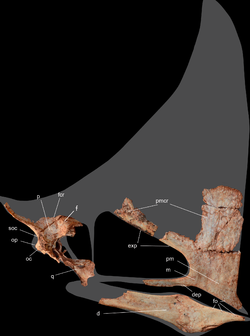Caiuajara
|
Caiuajara Temporal range: Late Cretaceous, 85 Ma |
|
|---|---|
 |
|
| Holotype skull | |
| Scientific classification | |
| Kingdom: | Animalia |
| Phylum: | Chordata |
| Class: | Reptilia |
| Order: | †Pterosauria |
| Suborder: | †Pterodactyloidea |
| Family: | †Tapejaridae |
| Genus: |
†Caiuajara Manzig et al., 2014 |
| Type species | |
|
†Caiuajara dobruskii Manzig et al. 2014 |
|
Caiuajara is an extinct genus of tapejarid pterosaur from the Late Cretaceous of Brazil. It is known from a single type species, Caiuajara dobruskii.
In 1971, the labourers Alexandre Dobruski and his son João Gustavo Dobruski found pterosaur fossils in a field near Cruzeiro do Oeste in the south of Brazil, in the state of Paraná. The finds were in 2011 brought to the attention of paleontologists Paulo C. Manzig and Luiz C. Weinschütz.
In 2014, the type species Caiuajara dobruskii was named and described by Paulo Manzig, Alexander Kellner, Luiz Weinschütz, Carlos Fragoso, Cristina Vega, Gilson Guimarães, Luiz Godoy, Antonio Liccardo, João Ricetti and Camila de Moura. The generic name refers to the geological Caiuá Group and the related genus Tapejara. The specific name honours the discoverers.
The holotype, CP.V 1449, was found in a sandstone layer of the Goio-Erê Formation, the age of which is uncertain; it is perhaps dating from the Coniacian-Campanian, very roughly about eighty-five million years old. It consists of a partial skeleton including the skull, lower jaws, neck vertebrae and wing elements. Many hundreds of bones have been discovered, concentrated in several bone beds, and representing at least forty-seven individuals but probably many more. In the total assembly, all elements of the skeleton are present. The bones have been three-dimensionally preserved, not compressed, but are only rarely articulated. The individuals found are often juveniles; adult animals are much rarer, only represented by two skulls and three humeri. Good specimens have been assigned as paratypes, the more fragmentary ones have been referred.
...
Wikipedia
